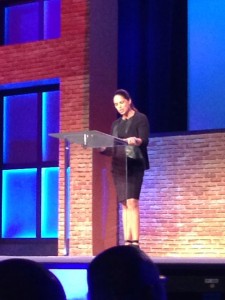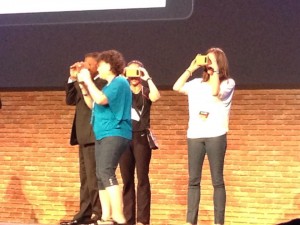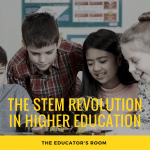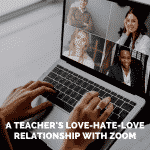[fusion_builder_container hundred_percent=”yes” overflow=”visible”][fusion_builder_row][fusion_builder_column type=”1_1″ background_position=”left top” background_color=”” border_size=”” border_color=”” border_style=”solid” spacing=”yes” background_image=”” background_repeat=”no-repeat” padding=”” margin_top=”0px” margin_bottom=”0px” class=”” id=”” animation_type=”” animation_speed=”0.3″ animation_direction=”left” hide_on_mobile=”no” center_content=”no” min_height=”none”]
You have seen her on CNN for a two decades. You might have caught one of her segments on HBO’s Real Sports, or NBC’s Today Show. But have you ever heard Soledad O’Brien talk tech?
The anchor/documentarian opened ISTE’s 2015 conference on Sunday night with a powerful, passionate keynote, in which she talked about the intersection of race, poverty, education, and technology. O’Brien, whose Starfish Media production house makes and distributes documentaries on race, class, poverty, and other need-to-know issues, firmly believes that technology can close the achievement gap, but with a major caveat.
“I think technology for technology’s sake is a complete waste,” the anchor asserted. “Technology leverages [/fusion_builder_column][fusion_builder_column type=”1_1″ background_position=”left top” background_color=”” border_size=”” border_color=”” border_style=”solid” spacing=”yes” background_image=”” background_repeat=”no-repeat” padding=”” margin_top=”0px” margin_bottom=”0px” class=”” id=”” animation_type=”” animation_speed=”0.3″ animation_direction=”left” hide_on_mobile=”no” center_content=”no” min_height=”none”][student] experience into something bigger, more powerful, more important.” O’Brien cited the example of stimulating girls’ interest in STEM fields by remarking, “Girls will embrace science and tech if it helps with problem solving.”
“Students who don’t have access to [tech] opportunities may never catch up,” O’Brien warned an enthusiastic, capacity crowd of more than 5000 conference-goers.
“Technology,” she continued, “is a tool that can change the world for students who need it.” Providing access to online classes, high-speed internet, and other platforms to underprivileged students can, according to O’Brien, “level the playing field through technology.”
O’Brien touched on her youth as the daughter of the only interracial couple in Smithtown, Long Island, NY. Her mother, who taught French and English at O’Brien’s high school, is a dark-complected Cuban; her white, Australian-native father taught mechanical engineering at the college level. O’Brien was aware of difference early on.
“We were outsiders, and reminded of that a lot,” O’Brien remarked. “ I just wanted to not stick out.”
After a stint at Harvard, O’Brien began her broadcasting career, and her awareness campaign, in Boston, where she gave airtime to issues of diversity and civil rights. She told the crowd, “[In] the narrative of the news, whether it was local or national…[presented] opportunities to open up and influence the kinds of stories told. I believe education today is the next civil right.”
O’Brien’s efforts to shine light on poverty and race in American education surfaced in a series of “Black in America” and “Latino in America” documentaries produced for CNN. O’Brien showed clips from her documentaries, including snippets of an African-American seven-year-old from Minneapolis who could not read at his second-grade level, and a Latina 11th-grader from Phoenix whose lack of access to a Calculus class cost her a Stanford education. O’Brien also ran tape of several students from the Bedford-Stuyvesant section of New York, who journeyed to South Africa with activist Malaak Compton-Rock to investigate the country’s education crisis firsthand. The students received Dell laptops to record and create meaning around their experiences by writing, blogging, generating letters, and producing other media content.
The CNN anchor discussed The Starfish Foundation, an effort she founded with her husband to help underprivileged young women to successfully complete college. Although the foundation provides scholarships to 25 women per year, O’Brien is adamant that tuition was not the most important component to the organization’s support plan. “My scholars were making very safe and uninspired career choices” due to lack of mentoring opportunities and exposure to varied career choices. The Starfish Foundation’s aim is to provide those

opportunities; O’Brien cited one scholarship recipient who was unaware of one such career path, and asked “Finance? What’s that?”
O’Brien demonstrated Google Cardboard, a 3D virtual media viewer made from corrugated paper, to the fascinated audience. Users were able to view and hear a veterinarian examining and operating on a cat, discussing career tracks in veterinary science, and detailing educational and economic opportunities available in her field. O’Brien asserts that Google Cardboard is only one platform available to bring higher-order learning opportunities to students who lack access.
In her speech, O’Brien appealed to the educator-heavy crowd. “I implore you to think about how you can change the world and bring real opportunity to the students who need it most.”
ISTE’s keynote speaker for Tuesday, June 30th is Jack Gallagher, an elementary teacher-turned comedian and advocate for autistic students. Josh Stumpenhorst, author, blogger, and 2011-12 Illinois Teacher of the Year, will deliver the closing keynote on Wednesday morning.[/fusion_builder_column][/fusion_builder_row][/fusion_builder_container]





